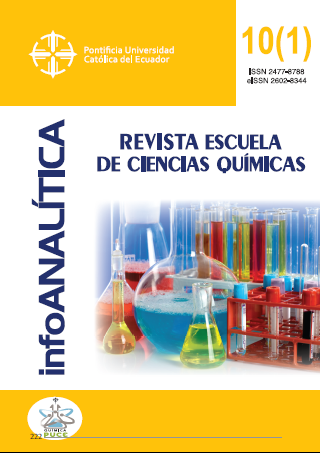SPECTROSCOPIC, MORPHOLOGICAL AND MICROANALYSIS CHARACTERIZATION OF THE BIOMASS OF OPUNTIA CARACASANA SALM-DYCK CLADODES
Main Article Content
Abstract
In this investigation, the biomass of Opuntia caracasana and a resulting material after treatment with KOH (TVM) were characterized spectroscopically, morphologically and by microanalysis. The results of the FTIR analysis indicated that the dry biomass contains functional groups that indicate the presence of lignin, cellulose, hemicellulose and pectin in the cladodes of the cactus. In addition, strong signals corresponding to the glycosidic ether of cellulose were identified in the material TVM. The morphology of the dry biomass and the material TMV were determined by Scanning Electron Microscopy coupled to an X- Ray Microanalysis Energy Dispersive Detector (SEM-EDS), the agglomerated crystals were observed on the surface of de dry biomass and the presence of cavities and fibers in the material TVM. By means of microanalysis, calcium was detected as the majority element in the dry biomass and was also detected in the material TVM. The results obtained allow us to infer that the dry biomass and the MVT material of O. caracasana have potentialities for the development of sustainable materials that can be used in the food and pharmaceutical industries and as adsorbents for pollutants in aqueous media.
Downloads
Article Details
- The authors agree to respect the academic information of other authors, and to assign the copyrights to the journal infoANALÍTICA, so that the article can be edited, published and distributed.
- The content of the scientific articles and the publications that appear in the journal is the exclusive responsibility of their authors. The distribution of the articles published in the infoANALÍTICA Journal is done under a Creative Commons Reconocimiento-CompartirIgual 4.0 Internacional License.
References
Aquilina, A., Borg, R. & Buhagiar, J. (2018). The application of natural organic additions in concrete: Opuntia ficus indica. IOP Conference Series: Materials Science and Engineering, 442, 1-11. DOI:10.1088/1757-899X/442/1/012016
Aquino, L., Rodríguez, J., Méndez, A. & Hernández, S. (2012). Extracción y caracterización de fibra de nopal. Naturaleza y Desarrollo, 10(1), 46-63.
Astello-García, M., Cervantes, I., Nair, V., Santos-Díaz, M., Reyes-Aguero, A., Guéraud, F., et al. (2015). Chemical composition and phenolic compounds profile of cladodes from Opuntia spp. cultivars with different domestication gradient. Journal of Food Composition and Analysis, (43), 119-130. DOI: 10.1016/j.jfca.2015.04.016.
Bakari, S., Daoud, A., Felhi, S., Smaoui, S., Ghaissallah, N. & Kadri, A. (2017). Proximate analysis, mineral composition, phytochemical contents, antioxidant and antimicrobial activities and GC-MS investigation of various solvent extracts of cactus cladodes. Food Science and Technology, 37(2), 286-293. DOI:10.1590/1678-457X.20116.
Belkheiri, A., Forouhar, A., Ursu A., Dubessay, P., Pierre, G., Delattre, C., et al. (2021). Extraction, characterization, and applications of pectins from plant by products. Applied Sciences, 11, 2-15. DOI:10.5772/intechopen.85588.
Carballo-Meilan, A., Hernández-Francisco, E., Sosa-Loyde, G., Bonilla-Cruz, J., Russell, P., et al. (2020). Biosorption of copper using nopal fibres: Moolorite formation and magnesium role in the reactive crystalization mechanism. Cellulose, (27), 10259-10276. DOI:10.1007/s10570-020-03449.
Castellano, J., Marrero, M., Ortega, Z., Romero, F., Beritz, A. & Ventura, M. (2021). Opuntia spp. Fibre characterization to obtain sustainable materials in the composites field. Polymers, (13), 2-21. DOI: 10.3390/polym13132085
Contreras-Padilla, M., Pérez-Torrero, E., Hernández- Urbiola, M., Hernández-Quevedo, G., Del Real, A., et al. (2011). Evaluation of oxalates and calcium in nopal pads (Opuntia ficus indica var redonda) at diferent maturity stages. Journal of Food Composition and Analysis, (24), 38-43. DOI: 10.1016/j.jfca.2010.03.028.
Contreras-Padilla, M., Rivera-Muñoz, E., Gutiérrez- Cortez, E., Real, A. & Rodríguez- García, E. (2015). Characterization of crystalline structures in Opuntia ficus indica. Journal of Biological Physic. (41), 99-112. DOI:10.1007/s10867-014-9368-6.
González, Y., Fuentes, L., Mendoza, I. & Caldera, Y. (2015). Opuntia ficus- Indica y Opuntia wentiana: Estudio comparativo sobre su efectividad como coagulantes en la clarificación del agua. Revista Tecnocientífica URU. 9, 81-89.
Lárez-Velásquez, C., Quiñonez, V., Suárez, D. & Santos, I. (2014). Preparación de un adsorbente basado en la ectodermis de los cladodios de tuna (Opuntia ficus) para la remoción del colorante safrarina. Química viva, 3(10), 221-232.
Lima de Assis, A., Pereira, L., Tavares, J.,Albuquerque, A., Pinheiro, E., Pereira de Azevedo, E. Oshiro-Junior, J. & Goulart de Lima, B. (2019) Opuntia ficus indica L Miller (Palma Forrageira) as an alternative source of celulose for production of pharmaceutica dosage forms and biomaterials: Extraction and characterization. Polymers, 11(7), 1-13. DOI: 10.3390/polym11071124.
Maldonado, Y., Salazar, S., Millones, E., Torres, E., & Vásquez, C. (2010). Extracción de pectina mediante el método de hidrólisis ácida en frutos de Maushan y Badillo. San Miguel de Soloco. Revista Aporte Santiaguino, 3(2): 177-184.
Mannai, F., Elhleli, H., Dufresne, A., Elaloui, E., & Moussoui. (2020a). Opuntia (Cactaceae) fibrous network-reinforced composites: Thermal, viscoelastic, interfacial adhesion and biodegradation behavior. Fibers and Polymers, 21(10), 2353-2363. DOI: 10.1007/s12221-020-9675-4.
Mannai, F., Khiari, R. & Moussaoui, Y. (2020b). Novel trend in the use of Opuntia (Cactaceae) fibers as potential feedstock for material science applications. En: Soto Hernández, M.,Reyes-Rivera, J. y Maceda-Rodriguez, A. Cactaceae- Current trends and future perspective. IntechOpen. DOI: 10. 5772/intechopen.92112.
Montilla, A., Tovar, I. & Pacheco, H. (2020). Cuantificación de pectinas en la pulpa del fruto de tres especies de tuna (Opuntioideae, Cactaceae). La Técnica: Revista de la Agrociencia, 23, 25-32.
Nharingo, T. & Moyo, M. (2016). Application of Opunta ficus-índica in bioremediation of wastewaters: A critical review. Journal of Environmental Management, 166, 55-72. DOI:10.1016/j.jenvman.2015.10.005
Ochoa, M. & Barbera, G. (2018). Historia e importancia agroecológica y económica. En: Inglese, P., Mondragón, C., Nefzaoui, A. y Sáenz, C. Eds. Ecología del cultivo, manejo y usos del nopal. Organización de las Naciones Unidas para la Alimentación y la Agricultura. Disponible en: https://www.fao.org/documents/card/es/c/I7628ES
Procacci, S., Bojórquez-Quintal, E., Platamone, G., Maccioni, O., Lo Veccio, V., Morreale, V., Alisi, C., Balducci, R. & Bacchetta, L. (2021). Opuntia ficus índica pruning waste recycling: Recovery and characterization of mucilague from cladodes. Natural Resources, 12, 91-107. DOI: 10.4236/nr.2021.124008.
Varela, C., Torres, G. & Censore, K. (2016) Variación morfométrica y biomasa floral entre poblaciones naturales de Opuntia caracasana Salm-Dyck (Cactaceae) en zonas áridas de Venezuela. Cactáceas y Suculentas Mexicanas, 61(3), 68-84.

